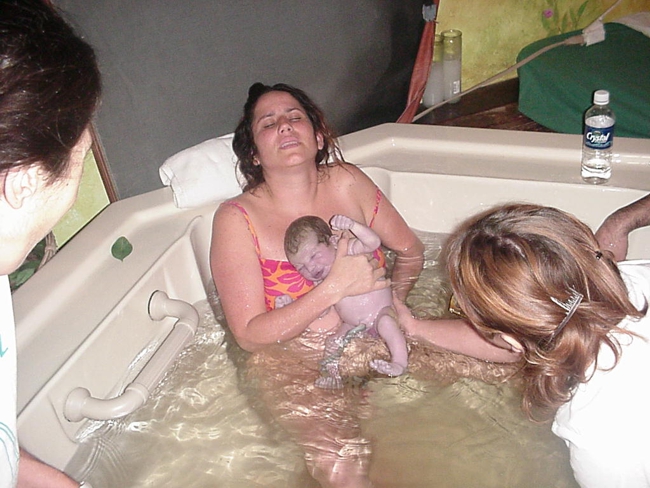
My name is Isabelle Guillou and I am a Certified Nurse Midwife. As a midwife, I’m very blessed to support families during their pregnancy and the birth of their newborn child. Everyone will agree that, whether be a natural birth or birth by cesarean section, a birth with an epidural or a physiological birth, every birth is life transforming. However, I have to admit that, of all types of births that I’ve witnessed, I’m fascinated with these water births. I have seen a lot of water births and I’m still amazed to see how soothing the water can feel to the mother and how her baby will transition quite smoothly. I know, some of you will say why in the world would women want to put themselves or their newborn baby at risk? Hence, I would like to go over some of the most common myths about waterbirth and refute these misunderstandings.
- Labor in the water cause hypotension (low blood pressure)
During water immersion, the hydrostatic pressure exerted by the water on the body reduces both peripheral edema and peripheral blood pressure. This hydrostatic pressure, which is greater at the bottom of the tub than at the surface, has an effect on the body by gently squeezing it like a tube of toothpaste. It is the pressure from the bottom up, which produces a significant shift of blood volume from the extremities to the chest, thus increasing the blood circulation to the vital organs (heart, lungs, brain and uterus), and improving cardiac and renal output, lung function, and uterine perfusion

- Women who labor in the water become dehydrated
During water immersion birth, the hydrostatic pressure exerted on the lower extremities causes a fluid shift from the extracellular space into the intravascular space and increases the blood flow to the vital orgasms, including the brain. Thirst cells, located in the brain, control the blood volume. When these cells swell up, thirst is inhibited. This may explain why women who labor in the water may not feel very thirsty. Studies have also demonstrated that oral nutrition is not only safe but actually optimizes outcomes and IV hydration does not improve birth outcomes. Regardless of where the woman labors, she is encouraged to take frequent sips of fluid throughout her labor to keep herself hydrated due to the exertion of energy.
- Mom’s body temperature can get too hot and baby’s heart rate can get too fast
Waterbirths pose no thermal risk to the mother and her infant as long as the water temperature remains within the physiological range (usually between 95-100). Water transfers heat far better than air. Because of this, water temperature has a profound effect on the body. If the water temperature exceeds 101 degrees Fahrenheit, it could lead to an increase in the mother’s body temperature, which could cause the baby’s heart rate to increase. If the temperature of the water is too cool (below 80°F), blood is shunted toward the core of the body to maintain body heat. As the water gets colder, muscles work less efficiently. When the water temperature is within physiologic range, more blood is available to working muscles. During water immersion, the water temperature is regularly monitored to ensure that the water temperature is within a comfortable range for the mother, usually between 95-100 degrees Fahrenheit. The mother’s vital signs and the baby’s heart rate are also regularly monitored to ensure that the mother’s heart rate as well as the baby’s remains within normal range.
.jpg)
- Labor is more likely to slow down or stop
Using water during labor can be soothing to the laboring woman. The relaxing effect of warm water can help the mother take deeper, more calming breaths to help with the discomforts of labor. Immersing in warm water during labor can help decrease adrenaline, the stress hormone. Adrenaline competes for the same receptor sites on the uterus and therefore has been shown to inhibit the effect of oxytocin, the main labor hormone responsible for creating strong and regular contractions. As the laboring woman enters the water, her contraction pattern may appear to slow down a little but because of the unhindered action of oxytocin, her labor pattern becomes more efficient and labor progresses better. Studies show that the length during the first and second stages of labor is significantly shorter with women who labor in the tub.

- Baby can drown or even die if born in the water
There are various criticisms about water birth and the risk of aspiration of water and drowning. The entry of water into the baby’s lungs can be avoided by lifting the baby out to the surface of the water as soon as possible. Babies by themselves will not breathe until exposed to air. Why doesn’t the newborn breathe underwater during a waterbirth? In utero, babies spend nine months in a sea of amniotic fluid. In utero, fetal breathing movements occur about 40% of the time with very little amniotic fluid being actually inhaled. About 48 hours before spontaneous labor, these “practice” fetal breathing movements’ stop, possibly because of a surge in levels of a hormone called prostaglandin E2. Babies also have an inbuilt physiological reflex, called the Dive Reflex that prevents them from taking a breath until they’re out in the open air. When an infant is born in the water and still fully submerged in the water, the larynx instinctively closes when water passes by, and the liquid is swallowed rather than inhaled. When the facial skin receptors come into contact with the oxygen and carbon dioxide in the air, along with cooler temperatures, the breathing movements will get started. It is also critical to know that severely low oxygen levels or high levels of carbon dioxide will trigger the gasp reflex before the baby has a chance to be brought out of the water and could result in water aspiration and drowning. This is why, during labor, your provider will frequently listen to the baby’s heart rate to assess for signs of hypoxia (low oxygen levels). Any baby born underwater should be brought to the surface within 10 seconds in a gentle manner and caution is given to ensure that the baby’s face doesn’t go back underwater.

- Babies born in the water have lower Apgars.
Some babies can be slower to initiate breathing; this is particularly common with waterbirth babies. These babies have good tone and slowly turn from bluish to pink. As long as the cord is left intact, the placenta is still oxygenating the baby; their color change may be the only obvious indication that they are making the transition. It can be difficult to even notice them begin to breathe. Most importantly, they need their placental circulation. While the cord is intact the baby is still receiving some oxygen, which is better than none. The cord pulses at the same rate as the baby’s heart, so feeling (or watching) it will reassure you that all is well. In addition, the extra blood volume and red blood cells will help to circulate any oxygen the baby gets into the lungs via external methods of resuscitation. Studies show that Apgars scores are unaffected by waterbirth. Neonates of women who had a waterbirth were less likely to experience a low 5-minute Apgar score, neonatal transfer to the hospital, and hospitalization or neonatal intensive care unit admission in the first 6 weeks when compared to non-waterbirth neonates.